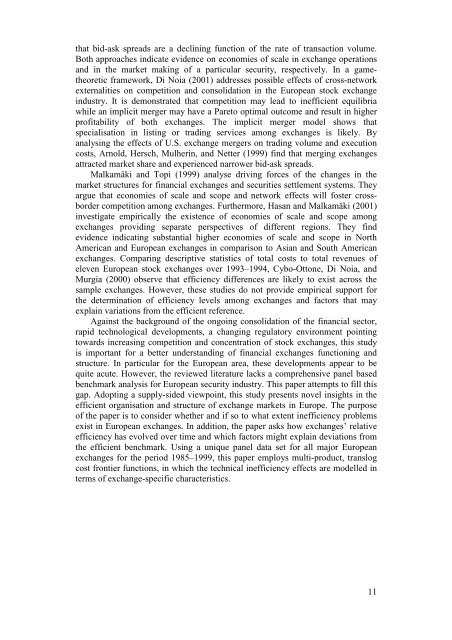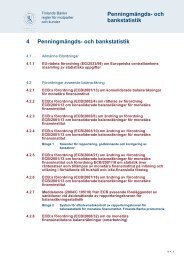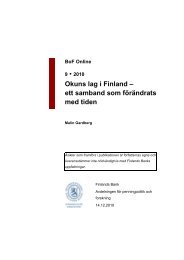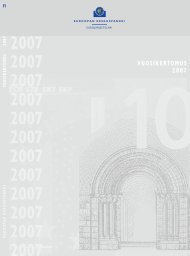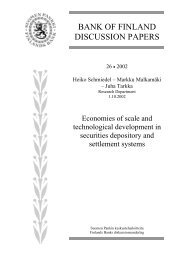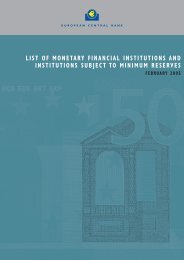Technological development and concentration of ... - Suomen Pankki
Technological development and concentration of ... - Suomen Pankki
Technological development and concentration of ... - Suomen Pankki
Create successful ePaper yourself
Turn your PDF publications into a flip-book with our unique Google optimized e-Paper software.
that bid-ask spreads are a declining function <strong>of</strong> the rate <strong>of</strong> transaction volume.<br />
Both approaches indicate evidence on economies <strong>of</strong> scale in exchange operations<br />
<strong>and</strong> in the market making <strong>of</strong> a particular security, respectively. In a gametheoretic<br />
framework, Di Noia (2001) addresses possible effects <strong>of</strong> cross-network<br />
externalities on competition <strong>and</strong> consolidation in the European stock exchange<br />
industry. It is demonstrated that competition may lead to inefficient equilibria<br />
while an implicit merger may have a Pareto optimal outcome <strong>and</strong> result in higher<br />
pr<strong>of</strong>itability <strong>of</strong> both exchanges. The implicit merger model shows that<br />
specialisation in listing or trading services among exchanges is likely. By<br />
analysing the effects <strong>of</strong> U.S. exchange mergers on trading volume <strong>and</strong> execution<br />
costs, Arnold, Hersch, Mulherin, <strong>and</strong> Netter (1999) find that merging exchanges<br />
attracted market share <strong>and</strong> experienced narrower bid-ask spreads.<br />
Malkamäki <strong>and</strong> Topi (1999) analyse driving forces <strong>of</strong> the changes in the<br />
market structures for financial exchanges <strong>and</strong> securities settlement systems. They<br />
argue that economies <strong>of</strong> scale <strong>and</strong> scope <strong>and</strong> network effects will foster crossborder<br />
competition among exchanges. Furthermore, Hasan <strong>and</strong> Malkamäki (2001)<br />
investigate empirically the existence <strong>of</strong> economies <strong>of</strong> scale <strong>and</strong> scope among<br />
exchanges providing separate perspectives <strong>of</strong> different regions. They find<br />
evidence indicating substantial higher economies <strong>of</strong> scale <strong>and</strong> scope in North<br />
American <strong>and</strong> European exchanges in comparison to Asian <strong>and</strong> South American<br />
exchanges. Comparing descriptive statistics <strong>of</strong> total costs to total revenues <strong>of</strong><br />
eleven European stock exchanges over 1993–1994, Cybo-Ottone, Di Noia, <strong>and</strong><br />
Murgia (2000) observe that efficiency differences are likely to exist across the<br />
sample exchanges. However, these studies do not provide empirical support for<br />
the determination <strong>of</strong> efficiency levels among exchanges <strong>and</strong> factors that may<br />
explain variations from the efficient reference.<br />
Against the background <strong>of</strong> the ongoing consolidation <strong>of</strong> the financial sector,<br />
rapid technological <strong>development</strong>s, a changing regulatory environment pointing<br />
towards increasing competition <strong>and</strong> <strong>concentration</strong> <strong>of</strong> stock exchanges, this study<br />
is important for a better underst<strong>and</strong>ing <strong>of</strong> financial exchanges functioning <strong>and</strong><br />
structure. In particular for the European area, these <strong>development</strong>s appear to be<br />
quite acute. However, the reviewed literature lacks a comprehensive panel based<br />
benchmark analysis for European security industry. This paper attempts to fill this<br />
gap. Adopting a supply-sided viewpoint, this study presents novel insights in the<br />
efficient organisation <strong>and</strong> structure <strong>of</strong> exchange markets in Europe. The purpose<br />
<strong>of</strong> the paper is to consider whether <strong>and</strong> if so to what extent inefficiency problems<br />
exist in European exchanges. In addition, the paper asks how exchanges’ relative<br />
efficiency has evolved over time <strong>and</strong> which factors might explain deviations from<br />
the efficient benchmark. Using a unique panel data set for all major European<br />
exchanges for the period 1985–1999, this paper employs multi-product, translog<br />
cost frontier functions, in which the technical inefficiency effects are modelled in<br />
terms <strong>of</strong> exchange-specific characteristics.<br />
11


